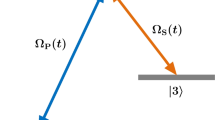Abstract
Stimulated Raman adiabatic passage (STIRAP) is an adiabatic population-transfer technique that uses two coherent laser pulses in counter-intuitive order, namely, pump and stoke, to achieve complete transfer between two quantum states. Here, we propose a double STIRAP scheme whereby the electronic levels of a four-level atom are coupled by three laser fields forming two pairs of stoke and pump pulses. We derive the optical Bloch equations through the master equation for studying the population dynamics. We show that manipulating the time between two STIRAP sequences provides the state transfer near unity. In particular, we show that there occurs a certain maximum transfer efficiency that can be achieved in the double STIRAP process.
Similar content being viewed by others
References
S. Haroche and J. M. Raimond, Exploring the Quantum, Oxford Graduate Texts, Oxford (2006).
K. Bergmann and B. W. Shore, in: H. L. Dai and R. W. Field (Eds.), Molecular Dynamics and Spectroscopy by Stimulated Emission Pumping, World Scientific, Singapore (1995).
J. Oreg, G. Hazak, and J. H. Eberly, Phys. Rev. A, 32, 27760 (1985).
D. Moller, L. B. Madsen, and K. Molmer, Phys. Rev. Lett., 100, 170504 (2008).
M. Fleischhauer, A. Imamoglu, and J. P. Marangos, Rev. Mod. Phys., 77, 633 (2005).
J. J. García-Ripoll, P. Zoller and J. I. Cirac, Phys. Rev. A, 71, 062309 (2005).
Marlan O. Scully and M. Suhail Zubairy, Quantum Optics, Cambridge University Press (1997).
C. Champenois, G. Morigi, and J. Eschner, Phys. Rev. A, 74, 053404 (2006).
Otto Stern, “Bending a molecular ray by crystal lattice face,” Naturwissenschaften, 17, 391 (1929).
I. Estermann, Am. J. Phys., 43, 661 (1975).
M. Saffman, T. G. Walker, and K. Molmer, Rev. Mod. Phys., 82, 2313 (2010).
M. Saffman and K. Molmer, Phys. Rev. Lett., 102, 240502 (2009).
J. Dieglmayr, M. Reetz-Lamour, T. Amthor, et al., Opt. Commun., 264, 293 (2006).
M. Reetz-Lamour, J. Deiglmayr, T. Amthor, and M. Weidemuller, New J. Phys., 10, 045026 (2008).
T. A. Johnson, E. Urban, T. Henage, et al., Phys. Rev. Lett., 100, 113003 (2008).
E. Urban, T. A. Johnson, T. Henage, et al., Nature Phys., 5, 110 (2009).
T. Vogt, M. Viteau, J. Zhao, et al., Phys. Rev. Lett., 97, 083003 (2006).
A. Gaëtan, Y. Miroshnychenko, T. Wilk, et al., Nature Phys., 5, 115 (2009).
S. E. Harris, Phys. Today, 50, 36 (1997).
G. S. Agarwal and Sumei Huang, Phys. Rev. A, 81, 041803(R) (2010).
G. Alzetta, A. Gozzini, L. Moi, and G. Orriols, Nuovo Cimento B, 36, 5 (1976).
M. D. Lukin, Rev. Mod. Phys., 75, 457 (2003).
K. Bergmann, H. Theuer, and B. W. Shore, Rev. Mod. Phys., 70, 1003 (1998).
I. I. Beterov, M. Saffman, E. A. Yakshina, et al., Phys. Rev. A, 88, 010303(R) (2013).
D. Moller, L. B. Madsen, and K. Molmer, Phys. Rev. Lett., 100, 170504 (2008).
P. Marte, P. Zoller, and J. L. Hall, Phys. Rev. A, 44, 4118(R) (1991).
Z. Kis and F. Renzoni, Phys. Rev. A, 65, 032318 (2002).
T. Pohl, E. Demler, and M. D. Lukin, Phys. Rev. Lett., 104, 043002 (2010).
I. I. Beterov, D. B. Tretyakov, V. M. Entin, et al., Phys. Rev. A 84, 023413 (2011).
J. R. Kuklinski, U. Gaubatz, F. T. Hioe, and K. Bergmann, Phys. Rev. A, 40, 6741 (1989).
M. J. Akram and F. Saif, “EIT controlled robust population transfer” (in preparation).
Author information
Authors and Affiliations
Corresponding author
Rights and permissions
About this article
Cite this article
Akram, M.J., Saif, F. Adiabatic Population Transfer Based on a Double Stimulated Raman Adiabatic Passage. J Russ Laser Res 35, 547–554 (2014). https://doi.org/10.1007/s10946-014-9461-0
Received:
Published:
Issue Date:
DOI: https://doi.org/10.1007/s10946-014-9461-0




